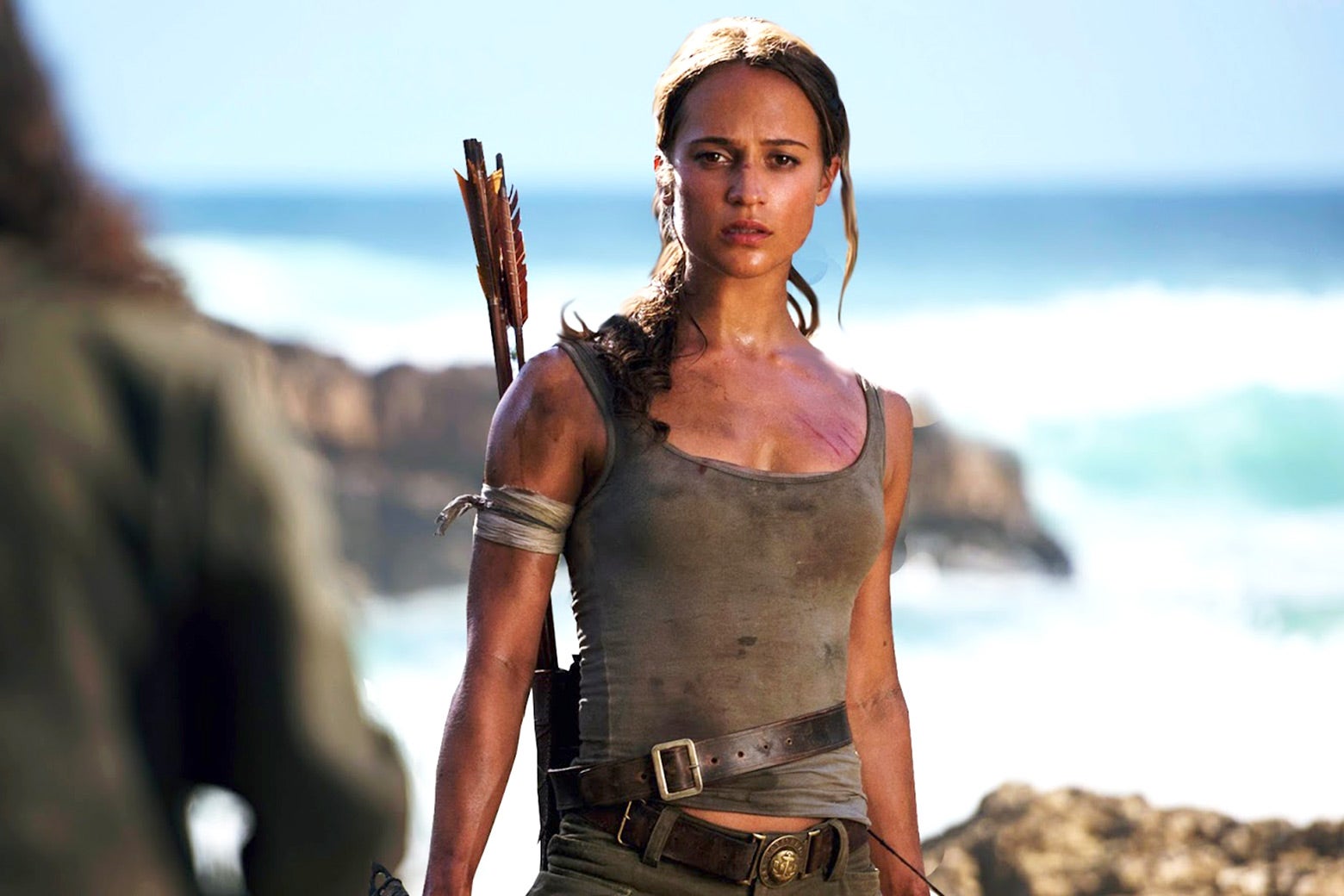I left the latest Tomb Raider film ready to hit the gym. This third adaptation of the video game franchise—and the first to star 2016 Oscar winner Alicia Vikander, who takes over for 2000 Oscar winner Angelina Jolie—is an adventure that’s enthralled by what bodies can do. Lara Croft, Tomb Raider’s Indiana Jones–esque protagonist, has long been a pop culture punchline for the disproportionate size of her breasts, and one of the many ways this Tomb Raider demonstrates self-awareness is by showcasing all the amazing feats that can be performed by that much-ogled physique. Like the Themyscira warriors in Wonder Woman who skirmished in ways that made sense for the female body, this Lara gets to execute fight choreography that looks and feels realistic for the figure we see on screen. It’s revelatory.
Another point in this Tomb Raider’s favor: It’s a 180-degree turn from Jolie’s smirking, statuesque pinup, a cartoonish male fantasy who practically haunted her ancestral castle in silky, flowing robes, like a superhot Miss Havisham. In keeping with its grounded, near-gritty tone, this origin story begins with Lara as a broke, urban hipster in skinny jeans and leather jackets, getting by on a food-delivery job and showing no exceptional talent at her boxing gym. As the daughter of a Richard Branson–like swashbuckling CEO (played by Dominic West), she’s got a Downton Abbey–esque manor and the inheritance to match, but she won’t touch either. Doing so would mean acknowledging that her father, last seen seven years ago, is most likely dead.
The daddy-daughter storyline is by far the clunkiest element in the script, by Geneva Robertson-Dworet and Alastair Siddons, so it’s a relief that Norwegian director Roar Uthaug (who last helmed the tsunami thriller The Wave) rarely stops the action for a heartfelt scene. Even before Lara arrives on the remote Japanese island where her father set sail in search of the burial site of a legendarily deadly royal, the picture doesn’t give her a moment of peace. She gets pummeled in the boxing ring, walloped some more during a bike race through London, and chased by thieves in a Hong Kong harbor where rickety wooden boats serve as a live-action platform game. (Vikander’s previous career as a ballerina was probably helpful here.) These occasional efforts to incorporate video game elements are mostly inconspicuous. In one breath-catching sequence that also happens to be the film’s funniest, Lara avoids falling down a giant waterfall, only to hold on to a quickly crumbling airplane wing, which lands her in a rusty hull that’s about to deposit her back into a watery grave. With such lucklessness, she can’t help but protest: “Really?”
Lara lands on the island with a drunken sailor (Daniel Wu) in tow and discovers that it’s far from the uninhabited rock she’d been told it was. A mission to find Queen Himiko’s crypt, led by the ruthless Mathias Vogel (Walton Goggins), has been underway for years, and the papers that she used to find her father’s last known destination turn out to be a boon for the rival archaeologist. But all that’s just plot. Tomb Raider’s soul lies in the American Ninja Warrior–style maneuvers that Lara uses to climb up from a hanging position, the strategies she can employ once the baddies’ bullets run out, and the bone-rattling thud when an aerial landing doesn’t go as planned. Even a scene in which she’s forced to kill a henchman in self-defense focuses on the physical exertion it takes to end a life. “She screams like a real person,” noted my screening partner. The only jarring detail—other than her completely hairless pits after days in the jungle—is that she has as much skin left as she does after getting into so many scrapes.
In these more sensitive times, this new Tomb Raider seems to go out of its way to show that Lara Croft is no self-serving looter. When she finally disturbs Queen Himiko’s sleep, it’s because she’s forced to by the villain. West and Vikander are able to make the insipid reunion between father and daughter work, but that relationship’s one interesting tension—whether Lord Croft’s belief that Queen Himiko’s vault contains supernatural powers means he’s crazy—finds a surprising and satisfying resolution.
An obligatory setup for a sequel slows down the final moments, but until then, Tomb Raider feels like a perfectly paced trio of espresso shots, with a shot of adrenaline to the heart as a chaser. It’s been a thrill to see so many physically powerful women on screen in recent years, but this deglammed Lara Croft feels like the rare heroine who proudly wears dirt under her chipped fingernails.
